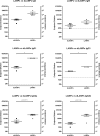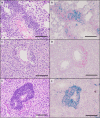B cells oppose Mycoplasma pneumoniae vaccine enhanced disease and limit bacterial colonization of the lungs
- PMID: 36310317
- PMCID: PMC9618410
- DOI: 10.1038/s41541-022-00556-z
B cells oppose Mycoplasma pneumoniae vaccine enhanced disease and limit bacterial colonization of the lungs
Abstract
Development of an effective vaccine for Mycoplasma pneumoniae has been hindered by reports of Vaccine Enhanced Disease (VED) in test subjects vaccinated and challenged in studies conducted in the 1960s. The exact mechanism of disease exacerbation has yet to be fully described, but host immune responses to Lipid-Associated Membrane Proteins (LAMPs) lipoprotein lipid moieties have been implicated. LAMPs-induced exacerbation appears to involve helper T cell recall responses, due in part to their influence on neutrophil recruitment and subsequent inflammatory responses in the lung. Herein, we characterized the functions of host B cell responses to M. pneumoniae LAMPs and delipidated-LAMPs (dLAMPs) by conducting passive transfer and B cell depletion studies to assess their contribution to disease exacerbation or protection using a BALB/c mouse model. We found that antibody responses to M. pneumoniae LAMPs and dLAMPs differ in magnitude, but not in isotype or subclass. Passive transfer, dLAMP denaturation, and monoclonal antibody studies indicate that antibodies do not cause VED, but do appear to contribute to control of bacterial loads in the lungs. Depletion of B cells prior to LAMPs-vaccination results in significantly enhanced pathology in comparison to B cell competent controls, suggesting a possible regulatory role of B cells distinct from antibody secretion. Taken together, our findings suggest that B cell antibody responses to M. pneumoniae contribute to, but are insufficient for protection against challenge on their own, and that other functional properties of B cells are necessary to limit exacerbation of disease in LAMPs-vaccinated mice after infection.
© 2022. The Author(s).
Conflict of interest statement
The authors declare no competing interests.
Figures






Similar articles
-
Lipid moieties of Mycoplasma pneumoniae lipoproteins are the causative factor of vaccine-enhanced disease.NPJ Vaccines. 2020 Apr 8;5(1):31. doi: 10.1038/s41541-020-0181-x. eCollection 2020. NPJ Vaccines. 2020. PMID: 32284882 Free PMC article.
-
Vaccination with Mycoplasma pneumoniae membrane lipoproteins induces IL-17A driven neutrophilia that mediates Vaccine-Enhanced Disease.NPJ Vaccines. 2022 Jul 29;7(1):86. doi: 10.1038/s41541-022-00513-w. NPJ Vaccines. 2022. PMID: 35906257 Free PMC article.
-
Induced mouse spleen B-cell proliferation and secretion of immunoglobulin by lipid-associated membrane proteins of Mycoplasma fermentans incognitus and Mycoplasma penetrans.Infect Immun. 1994 Sep;62(9):3916-21. doi: 10.1128/iai.62.9.3916-3921.1994. Infect Immun. 1994. PMID: 8063408 Free PMC article.
-
[Novel vaccines against M. tuberculosis].Kekkaku. 2006 Dec;81(12):745-51. Kekkaku. 2006. PMID: 17240920 Review. Japanese.
-
Immunization against Mycoplasma pneumoniae disease: a review.Isr J Med Sci. 1984 Oct;20(10):912-5. Isr J Med Sci. 1984. PMID: 6439678 Review.
Cited by
-
Efficacy and Influencing Factors of Sangju Cough Mixture in the Adjuvant Treatment of Adult Patients with Mycoplasma pneumoniae Infection: A Retrospective Study.Infect Drug Resist. 2024 Jan 26;17:275-282. doi: 10.2147/IDR.S438202. eCollection 2024. Infect Drug Resist. 2024. PMID: 38298533 Free PMC article.
-
Vimentin Is an Attachment Receptor for Mycoplasma pneumoniae P1 Protein.Microbiol Spectr. 2023 Mar 13;11(2):e0448922. doi: 10.1128/spectrum.04489-22. Online ahead of print. Microbiol Spectr. 2023. PMID: 36912679 Free PMC article.
-
Mycoplasma pneumoniae: not a typical respiratory pathogen.J Med Microbiol. 2024 Oct;73(10):001910. doi: 10.1099/jmm.0.001910. J Med Microbiol. 2024. PMID: 39475213 Free PMC article. Review.
References
Grants and funding
LinkOut - more resources
Full Text Sources

